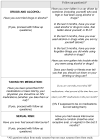Depression and stigma in high-risk youth living with HIV: a multi-site study
- PMID: 22726715
- PMCID: PMC3383773
- DOI: 10.1016/j.pedhc.2011.02.014
Depression and stigma in high-risk youth living with HIV: a multi-site study
Abstract
Introduction: This study explored the relationship between depression, stigma, and risk behaviors in a multi-site study of high-risk youth living with HIV (YLH) in the United States.
Methods: All youth met screening criteria for either problem level substance use, current sexual risk, and/or suboptimal HIV medication adherence. Problem level substance use behavior was assessed with the CRAFFT, a six-item adolescent screener. A single item was used to screen for current sexual risk and for an HIV medication adherence problem. Stigma and depression were measured via standard self-report measures.
Results: Multiple regression analysis revealed that behavioral infection, older age, more problem behaviors, and greater stigma each contributed to the prediction of higher depression scores in YLH. Associations between depression, stigma, and problem behaviors are discussed. More than half of the youth in this study scored at or above the clinical cut-off for depression. Results highlight the need for depression-focused risk reduction interventions that address stigma in YLH.
Discussion: Study outcomes suggest that interventions are needed to address stigma and depression, not only among youth living with HIV, but in the communities in which they live.
Copyright © 2012 National Association of Pediatric Nurse Practitioners. Published by Mosby, Inc. All rights reserved.
Conflict of interest statement
Conflicts of interest: None to report
Figures
References
-
- Berger BE, Ferrans CE, Lashley FR. Measuring stigma in people with HIV: psychometric assessment of the HIV stigma scale. Research Nursing Health. 2001;24:518–529. - PubMed
-
- CDC. 2009 www.cdc.gov.
-
- Derogatis L, Spencer P. Brief Symptom Inventory: Administration, Scoring, and Procedures Manual-I. Baltimore: Clinical Psychometric Research, NC; 1982.
-
- Ferrando SJ. Psychopharmacologic treatment of patients with HIV/AIDS. Current Psychiatry Reports. 2009;11 (3):235–242. - PubMed
Publication types
MeSH terms
Grants and funding
LinkOut - more resources
Full Text Sources
Medical
Miscellaneous



